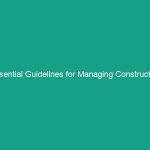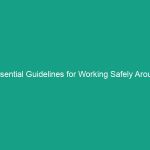Good Morning Team!
Today, we’re diving into a crucial topic that directly affects our health and Safety on the job: Essential Respirator Donning Guidelines. As we navigate various tasks that may expose us to airborne contaminants, understanding how to properly wear and use respirators is vital. This Toolbox Talk aims to equip you with the knowledge and skills to avoid common mistakes and ensure your Safety while working. Let’s get started!
Understanding Essential Respirator Donning Guidelines
Respirators are protective devices designed to filter out harmful particles from the air we breathe, thus safeguarding our health. Proper donning of a respirator is critical as it ensures a tight seal and effective filtration, which directly impacts your safety. Missteps in this process can lead to serious health risks, including respiratory illnesses or exposure to hazardous substances.
One common misconception is that simply wearing a respirator is enough for protection. However, improper donning can render even the best respirators ineffective. Understanding the essential guidelines for donning a respirator is not just a matter of compliance—it’s a matter of your health and well-being.
Key Hazards, Risks, and Safety Considerations
When it comes to respirators, several Hazards and risks can arise from improper use:
- Inadequate Seal: If the respirator is not properly fitted, harmful particles can enter, leading to exposure.
- Incorrect Type: Using the wrong type of respirator for specific contaminants can increase risk significantly.
- Contamination: Touching the respirator after donning can lead to contamination of your face and respiratory system.
The real-world consequences of ignoring proper donning Procedures can be severe, affecting not only your health but also your ability to work safely. For example, an unsealed respirator can lead to overexposure to chemical vapors, resulting in long-term health problems.
Best Practices, Procedures, & Actionable Advice
Now that we understand the importance of proper respirator donning, let’s go over the Best Practices and procedures to follow:
Step-by-Step Safety Procedures for Donning a Respirator
- Preparation: Before donning, ensure your hands are clean and dry. Inspect the respirator for any damage or defects.
- Position the Respirator: Hold the respirator in your hands and position it over your nose and mouth.
- Secure the Straps: Place the top strap over the crown of your head, then pull the bottom strap over the nape of your neck. Adjust the straps to ensure a snug fit.
- Check the Seal: Perform a user seal check by inhaling sharply. If the respirator collapses slightly, the seal is good. If you feel air leaking, readjust the straps.
- Final Adjustments: Make any necessary adjustments for comfort and functionality before entering the work area.
Always remember, if you’re unsure about the fit or the type of respirator, ask for assistance. It’s better to take a few extra minutes to ensure your safety than to rush and risk exposure.
Real-Life Example
Consider the case of a worker who donned a respirator improperly. Despite wearing it, he was exposed to toxic fumes due to a poor seal. This incident led to a serious respiratory illness that could have been avoided had he followed the proper donning procedure. This is a stark reminder of the importance of our discussion today.
Regulations, Standards, and Compliance
Compliance with safety Standards is not just a legal obligation; it’s a critical component of Workplace Safety. The Occupational Safety and Health Administration (OSHA) provides clear guidelines on respiratory protection, which include:
- Fit Testing: Regular fit testing is required to ensure that respirators fit properly.
- Training: Employees must be trained on the correct use and Maintenance of respirators.
- Inspection: Regular inspections of respirators should be conducted to ensure they are in good working order.
By adhering to these Regulations, we not only protect ourselves but also contribute to a safer work Environment. Each of us has a role in maintaining compliance and ensuring that safety protocols are followed.
Employee Engagement & Discussion
Now that we’ve covered the essential guidelines for donning respirators, let’s engage in a discussion. Here are some questions to consider:
- What challenges have you encountered when donning your respirator?
- Do you have any tips or personal experiences that could help others improve their donning technique?
- How can we ensure that everyone on the team is comfortable asking for help when needed?
Your insights are valuable, and sharing them can help us all improve our safety practices.
Conclusion & Key Takeaways
To wrap up, let’s review the key points we discussed today:
- Understanding the importance of proper respirator donning is essential for Workplace Safety.
- Following the correct procedures can significantly reduce the risk of exposure to hazardous substances.
- Compliance with osha regulations is crucial for the safety of all employees.
Let’s take these guidelines to heart and prioritize our safety every day. Thank you for your attention and commitment to maintaining a safe work environment. Remember, safety is not just a priority; it’s our responsibility!


